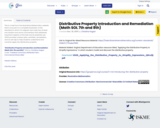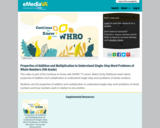
Model and discover the distributive property to simplify expressions - Algebra Readiness Remediation Plan
- Subject:
- Mathematics
- Material Type:
- Lesson Plan
- Provider:
- VDOE
- Author:
- VDOE
- Date Added:
- 10/07/2024

Model and discover the distributive property to simplify expressions - Algebra Readiness Remediation Plan

Applying the Distributive Property Algebra Readiness Remediation Plan

This is a task from the Illustrative Mathematics website that is one part of a complete illustration of the standard to which it is aligned. Each task has at least one solution and some commentary that addresses important aspects of the task and its potential use. VDOE provides a lesson plan, activities, remediation, and an exit slip to help students understand and correctly apply the distributive property.

This is a task from the Illustrative Mathematics website that is one part of a complete illustration of the standard to which it is aligned. Each task has at least one solution and some commentary that addresses important aspects of the task and its potential use. VDOE provides a lesson plan, activities, remediation, and an exit slip to help students understand and correctly apply the distributive property.

Unit 3 extends the study of factors from 2, 3, 4, 5, and 10, which students explored in Unit 2, to include all units from 0 to 10, as well as multiples of 10 within 100. To work with these more challenging units, students will rely on skip-counting (a Level 2 strategy) and converting to an easier problem (a Level 3 strategy dependent on the properties of operations). They then will apply their understanding of all four operations to two-step word problems as well as arithmetic patterns. Finally, the unit culminates with a focus on categorical data, where students draw and solve problems involving scaled picture graphs and scaled bar graphs, a nice application of the major work of multiplication and division.
Topic A begins by reminding students of the commutative property they learned in Unit 2, as well as introducing them to the distributive and associative properties, upon which they will rely for many of the strategies they learn for the larger factors. In order to be able to use these properties, they need to understand how to compute with a factor of 1, which they explore along with 0, as well as understand how to use parentheses. They’ll then explore the factors of 6, 7, 8, and 9 in Topics B and C. Because of the increased difficulty of these facts, students will rely on both skip-counting (a Level 2 strategy) as well as converting to an easier problem (a Level 3 strategy). Converting to an easier problem is dependent on the properties of operations (e.g., to find 6 x 7, think of 5 x 7 and add a group of 7 is dependent on the distributive property). Thus, students will work with the properties extensively throughout the unit, with their understanding of them and notation related to them growing more complex and abstract throughout the unit. In Topic D, students will multiply one-digit numbers by multiples of 10 and by two-digit numbers using the associative property. Then, students solve two-step word problems involving all four operations, assessing the reasonableness of their answer, and identify arithmetic patterns and explain them using the properties of operations. Finally, students explore picture graphs in which each picture represents more than one object and bar graphs where the scale on the axis is more than 1, a key development from Grade 2 (3.MD.3). As the Progressions note, “these developments connect with the emphasis on multiplication in this grade” (MD Progression, p. 7). Students also solve one- and two-step word problems related to the data in these plots, relying on the extensive work students have done with word problems throughout the year. Thus, this supporting cluster standard nicely enhances the major work they’ve been working on throughout this and the previous unit.
In Unit 3, students deepen their understanding of multiplication and division, including their properties. “Mathematically proficient students at the elementary grades use structures such as…the properties of operations…to solve problems” (MP.7) (Standards for Mathematical Practice: Commentary and Elaborations for K–5, p. 9). Students use the properties of operations to convert computations to an easier problem (a Level 3 strategy), as well as construct and critique the reasoning of others regarding the properties of operations (MP.3). Lastly, students model with mathematics with these new operations, solving one- and two-step equations using them (MP.4).

In Unit 4, students understand area as how much two-dimensional space a figure takes up and relate it to their work with multiplication in Units 2 and 3.
In early elementary grades, students may have informally compared area, seeing which of two figures takes up more space. In Grade 2, students, partitioned a rectangle into rows and columns of same-sized squares and counted to find the total number of them, including skip-counting and repeated addition to more efficiently do so (2.G.2, 2.OA.4).
Students begin their work in this unit by developing an understanding of area as an attribute of plane figures (3.MD.5) and measure it by counting unit squares (3.MD.6). After extensive work to develop students’ spatial structuring, students connect area to the operation of multiplication of length and width of the figure (3.MD.7a, b). Lastly, students connect the measure of area to both multiplication and area, seeing with concrete cases that the area of a rectangle with whole-number side lengths a and b+c is the sum of a×b and a×c (3.MD.7c), and using the more general idea that area is additive to find the area of composite figures (3.MD.7d). Thus, the unit serves as a way to link topics and thinking across units, providing coherence between the work with multiplication and division in Units 2 and 3 (3.OA) with the work of area in this unit (3.MD.C).
Students will engage with many mathematical practices deeply in the unit. For example, students “use strategies for finding products and quotients that are based on the properties of operations; for example, to find [the area of a rectangle by multiplying] 4×7, they may recognize that 7=5+2 and compute 4×5+4×2. This is an example of seeing and making use of structure (MP.7). Such reasoning processes amount to brief arguments that students may construct and critique (MP.3)” (PARCC Model Content Frameworks for Mathetmatics, p. 16). Further, students make use of physical tiles, rulers to relate side lengths to physical tiles, and later in the unit, the properties of operations themselves in order to find the area of a rectangle (MP.5). Additionally, “to build from spatial structuring to understanding the number of area-units as the product of number of units in a row and number of rows, students might draw rectangular arrays of squares and learn to determine the number of squares in each row with increasingly sophisticated strategies, such as skip-counting the number in each row and eventually multiplying the number in each row by the number of rows (MP.8)” (GM Progression, p. 17).

This video is part of the Continue to Know with WHRO TV series. Watch Emily Rathbone teach about properties of addition and multiplication to understand single-step word problems of whole numbers.